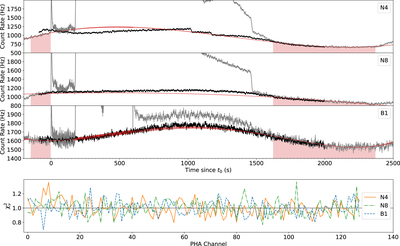Image Details

Caption: Figure 3.
Top: the gray light curves are of GRB 221009A as seen in Fermi-GBM detectors N4, N8, and B1. The black light curves are the averaged background from 30 orbits before and 30 orbits after the Fermi-GBM trigger time, when Fermi was in the same orbital location and orientation. The red shaded regions mark the background selection regions used for polynomial fitting. The red lines are the fourth order polynomial fits to the GRB 221009A light curves that best match the averaged orbital background. The gray shaded area on the right marks the time when the GRB was occulted by the Earth. The discrepancy at t = 0 between the gray GRB light curve and the black averaged background light curve in panel N4 is due to the propagation of the Earth occultation steps in the orbital fits (as seen around 1100 s and 1200 s). The polynomial order and background range can be found in Section 5. Bottom: the ﹩{\chi }_{\nu }^{2}﹩ fits of the polynomial fit to the GRB 221009A light curve in each of the 128 CSPEC energy bins for each detector.
Copyright and Terms & Conditions
© 2023. The Author(s). Published by the American Astronomical Society.









